Infectious Diseases
Over the previous centuries, global pandemics of infectious diseases, such as smallpox, cholera, and influenza, periodically threatened the survival of entire populations. By the mid-twentieth century, safe, effective, and affordable vaccines and the increasing availability of antibiotics had further reduced the toll of infectious diseases in high-income countries.
Not until the second half of the twentieth century did large-scale efforts begin to better control infectious diseases in low- and middle-income countries, where the infectious disease burden was greatest and highly varied. A survey in 1998 revealed that infectious diseases accounted for about 50% of the disease burden in India. Not much has changed in 2020.
Read and Learn More Pathophysiology
Meningitis: Bacterial meningitis is the most common and serious bacterial infection of the central nervous system (CNS), characterized by an acute purulent infection of the meninges around the brain and spinal cord (pia mater, arachnoid) and subarachnoid space.
Without prompt antibiotic treatment, bacterial meningitis is serious and can be fatal within days. Delayed treatment increases the risk of permanent brain damage or death Approximately 1.2 million cases are estimated to suffer from bacterial meningitis annually worldwide, resulting in 135,000 deaths.
The Meninges: The meninges comprise three membranes that, together with the cerebrospinal fluid, enclose and protect the brain and spinal cord. The pia mater is a very delicate impermeable membrane that firmly adheres to the surface of the brain. The arachnoid mater is a loosely fitting sac on top of the pia mater.
The subarachnoid space separates the arachnoid and pia mater membranes and is filled with cerebrospinal fluid. The outermost membrane, the dura mater, is a thick durable membrane, which is attached to both the arachnoid membrane and the skull.
Meningitis Symptoms And Signs: Early meningitis symptoms may mimic upper respiratory tract infection. Symptoms may develop over several hours or over a few days. Possible signs and symptoms in anyone older than the age of 2 include
- Sudden high fever
- Stiff neck
- Severe headache
- Headache with nausea or vomiting
- Confusion or difficulty concentrating
- Seizures
- Sleepiness or difficulty waking
- Photophobia (sensitivity to light)
- No appetite or thirst
- Skin rash (sometimes, such as in meningococcal meningitis).
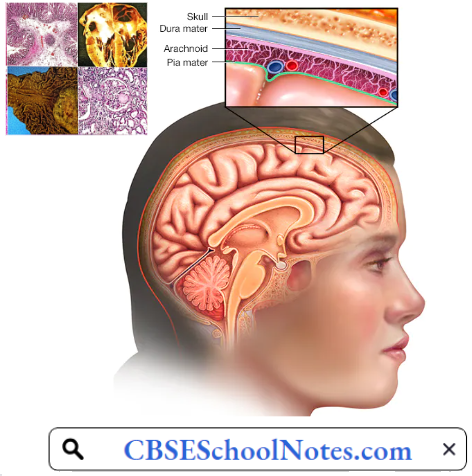
Meningitis Causes
- Bacterial Meningitis: Bacteria that enter the bloodstream and travel to the brain and spinal cord cause acute bacterial meningitis. Pneumococcus or meningococcus type of bacteria are causative organism.
- Viral Meningitis: The symptoms of viral meningitis are the same as in bacterial meningitis, but milder. Viral meningitis often clears on its own. In most cases, there is no specific treatment for viral meningitis. Most people who get mild viral meningitis usually recover completely in 7 to 10 days without treatment.

Since bacterial meningitis is a serious disorder, it is important to differentiate from viral meningitis. One of the tests for this differentiation is the physical appearance, chemical analysis, and microscopic examination of cerebrospinal fluid (CSF) obtained by lumbar puncture in the patient.
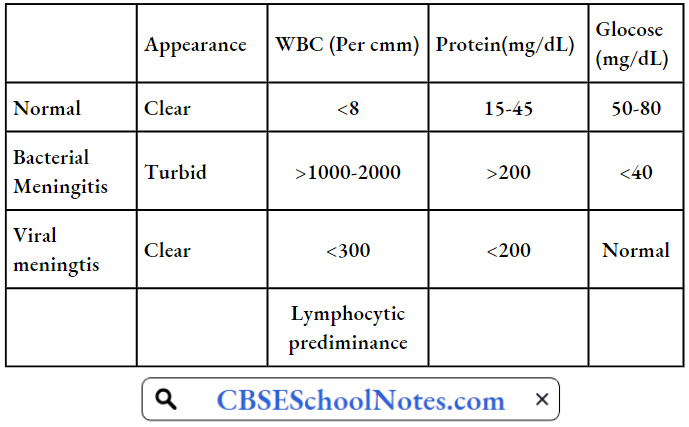

- The CSF in bacterial meningitis is characterized by being turbid in appearance, decreased glucose concentration, increased protein concentration, and a large number of white blood cells, chiefly neutrophils.
- The CSF in viral meningitis is clear in appearance, with normal sugar concentration, only a mild increase in protein concentration, and a lesser number of white blood cells, chiefly lymphocytes.
Physical Appearance And Chemical Composition Of Csf In Bacterial And Viral Meningitis: In most cases, the disorder starts with a viral upper respiratory infection which breaks down the protective barrier provided by the mucous membrane of the nasal cavity.
- As a result, bacteria that normally reside on the nasal mucous membrane are able to enter the bloodstream. Once bacteria have entered the bloodstream, they enter the subarachnoid space in places where the blood-brain barrier is relatively weak, i.e. the choroid plexus.
- The cerebrospinal fluid present in the subarachnoid space is an ideal medium for the proliferation of bacteria because it has enough nutrients and very few phagocytic cells.
- Cells of the innate immune system of CNS (microglia and astrocytes) located in the choroid plexus and ependyma, detect bacteria and secrete cytokines and chemokines which attract circulating granulocytes into CSF.
- Granulocytes and macrophages contain powerful lysosomal enzymes used to kill the bacteria, but these cells have short lifespans. On senescence, these cells release proteolytic enzymes into cerebral interstitial space and damage the brain tissue and blood vessels (vasculitis).
- So the brain damage in bacterial meningitis is partly due to bacteria and partly by inflammatory response. The most dangerous complication of bacterial meningitis is increased intracranial pressure from cerebral edema.
- Cerebral edema results from greater permeability of the blood-brain barrier, increased cerebral hypoxia, and cellular toxicity. Increased intracranial pressure, in turn, causes decreased cerebral perfusion, ischemia, hypoxia, and neuronal necrosis.

Meningitis Complications: Meningitis complications can be severe. The longer the delay in the start of treatment, the greater is the brain damage and other complications, including
- Hearing loss.
- Ataxia.
- Cortical blindness.
- Mental retardation.
- Other cranial nerve dysfunction.
- Kidney failure
- Paralysis.
- Death.
- Muscular hypertonia.
Typhoid Fever: Typhoid, also called typhoid fever, occurs all over the world. In 2015, 12.5 million new cases worldwide were reported. The risk of death may be as high as 20% without treatment. In 2015, it resulted in about 149,000 deaths worldwide. The disease is endemic in India, Southeast Asia, Africa, and South America.
Typhoid Fever Symptoms And Signs
- In the first week, the body temperature rises slowly, and fever fluctuations are seen with malaise, headache, and cough.
- In the second week, high fever around 40°C (104°F). The abdomen is distended and painful in the right lower quadrant. The spleen and liver are enlarged (hepatosplenomegaly).
- In the third week of typhoid fever, a number of complications can occur
- Intestinal hemorrhage due to bleeding in congested Peyer’s patches;
- Intestinal perforation in the distal ileum is a very serious complication and is frequently fatal.
- Septicaemia or peritonitis.
Typhoid Fever Cause: Typhoid fever is caused by a virulent bacteria called Salmonella typhi. The bacteria that cause typhoid fever spread through contaminated food or water. The patient or the carrier passes bacteria in the feces.
You can contract the infection if you eat food handled by someone with typhoid fever who hasn’t washed his hands carefully after using the toilet. You can also become infected by drinking water contaminated with the bacteria.

Typhoid Fever Pathogenesis: Salmonella organisms penetrate the mucosa of the small intestine and proliferate in the mucosal epithelial cells. Next, the bacteria proliferate in the Payer’s patches (submucosal collection of lymphoid tissue) of the lower small intestine from where systemic dissemination occurs to the reticuloendothelial system of the liver and spleen.

For a period varying from 1 to 3 weeks, the organism multiplies within these organs. Invasion of the mucosa causes the epithelial cells to synthesize and release various proinflammatory cytokines responsible for most of the symptoms of typhoid fever.

Ulceration over Payer’s patches accounts for complications such as bleeding, perforation, and peritonitis. Proliferation in the reticuloendothelial system leads to enlargement and congestion of the spleen and liver.
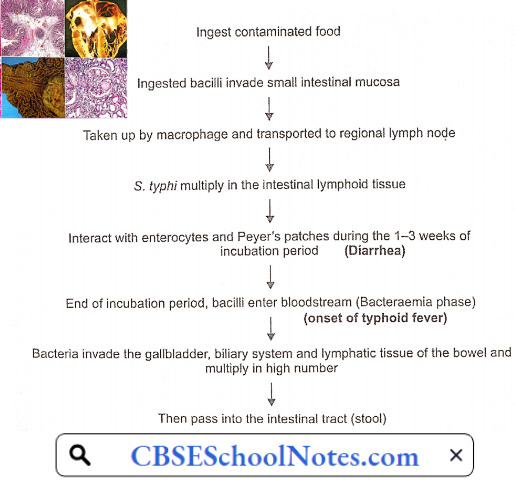
Typhoid Fever Complications
- Intestinal hemorrhage
- Intestinal perforation
- Septicaemia
Tuberculosis: In 2018, an estimated 10 million people fell ill with tuberculosis (TB) worldwide. A total of 1.5 million people died from TB in 2018. Worldwide, TB is one of the top 10 causes of death and the leading cause from a single infectious agent.
Tuberculosis generally affects the lungs, but can also affect other parts of the body. About 25T of TB patients of the world are Indians. In India, each year, approx. 220,000 deaths are reported due to tuberculosis.
Pulmonary Tuberculosis: Tuberculosis Symptoms And Signs
- Cough up sputum
- Cough up blood
- Consistent low-grade fever
- Night sweats
- Chest pains
- Unexplained weight loss
Tuberculosis Cause: Pulmonary TB is caused by the bacterium Mycobacterium tuberculosis. TB is contagious. This means the bacteria is easily spread from an infected person to someone else. You can get TB by breathing in air droplets from a cough or sneeze of an infected person. The resulting lung infection is called primary TB.

Tuberculosis Pathogenesis: The characteristic pathologic changes depend on the type of infection
- Primary Pulmonary TB (primary exposure) is characterized by the Ghon complex which consists of
- Subpleural focus of tubercular inflammation.
- Infected (inflamed) lymph nodes draining the primary subpleural lesion.
- Secondary Pulmonary TB (reactivation) is characterized by a focus of infection and granuloma formation usually in the apex of the lung. The small granulomas (tubercles) eventually coalesce to form larger areas of consolidation with central caseating necrosis. Regional lymph nodes contain caseating granulomas.
- Progressive Pulmonary TB: Primary or secondary TB may go on to heal as caseating granulomas are replaced by fibrosis and calcification. However, if the case does not heal spontaneously or with therapy, the disease progresses to form cavities or spread to other parts of the lung and other organs of the body through lymphatic channels and the bloodstream.
Primary Tuberculosis: The tubercle bacilli establish infection in the lungs after they are carried in droplets small enough (5 to 10 microns) to reach the alveolar spaces. If the defense system of the host fails to eliminate the infection, the bacilli proliferate inside alveolar macrophages and eventually kill the cells.
The infected macrophages produce cytokines and chemokines that attract other phagocytic cells, including monocytes, other alveolar macrophages, and neutrophils, which eventually form a nodular granulomatous structure called the tubercle.

If the bacterial replication is not controlled, the tubercle enlarges and the bacilli enter local draining lymph nodes. This leads to lymphadenopathy, a characteristic clinical manifestation of primary tuberculosis. The lesion produced by the expansion of the tubercle into the lung parenchyma and lymph node involvement is called the Ghon complex.
Unchecked bacterial growth may lead to hematogenous spread of bacilli to produce disseminated TB in various vital organs of the body. Disseminated disease with lesions resembling millet seeds is termed miliary TB. In the absence of treatment, death ensues in 80% of cases.
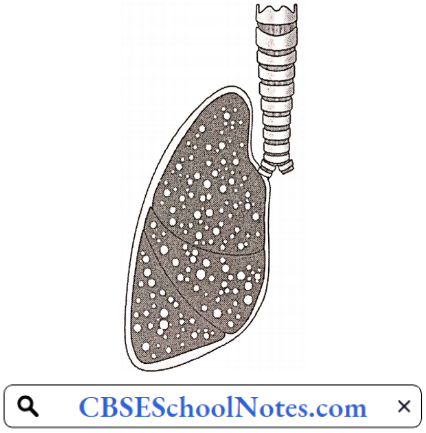
The remaining patients develop chronic disease or recover. Chronic disease is characterized by repeated episodes of healing by fibrotic changes around the lesions and tissue breakdown. Complete spontaneous eradication of the bacilli is rare.
Tuberculosis Reactivation Disease: Reactivation TB results from the proliferation of a previously dormant bacterium seeded at the time of the primary infection. Among individuals with latent infection and no underlying medical problems, reactivation disease occurs in 5 to 10 percent.
It is not clear what specific host factors maintain the infection in a latent state and what triggers the latent infection to become overt. The disease process in reactivation TB tends to be localized (in contrast to primary disease): There is little regional lymph node involvement and less caseation.

The lesion typically occurs at the lung apices, and disseminated disease is unusual unless the host is severely immunosuppressed. It is generally believed that successfully contained latent TB confers protection against subsequent TB exposure.
In many people, the infection waxes and wanes. Tissue destruction and necrosis are often balanced by healing and fibrosis. Affected tissue is replaced by scarring and cavities filled with caseous necrotic material. Tissue destruction and necrosis are often balanced by healing and fibrosis.
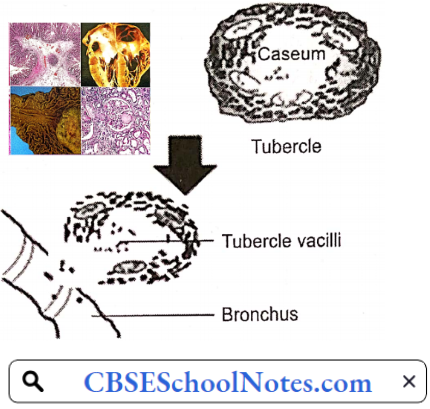
Affected tissue is replaced by scarring and cavities filled with caseous necrotic material. During active disease, some of these cavities are joined to the bronchi and this material can be coughed up. The sputum contains living bacteria and thus can spread the infection.
Tuberculosis Risk factors
- Contact with a patient of TB
- Live in crowded or unclean living conditions
- Have poor nutrition
Tuberculosis Complications
- Hemoptysis
- Pleurisy
- Pleural effusion
- Empyema
- Pneumothorax
Leprosy: Leprosy currently affects approximately a quarter of a million people throughout the world, with the majority of these cases being reported from India. India is currently running one of the largest leprosy eradication programs in the world.
- Despite this, 120,000 to 130,000 new cases of leprosy are reported every year in India. This is 58.8% of the global total of new cases. Leprosy colonies exist throughout India. These are typically made up of patients that have moved to the colony often from a significant distance away, along with their children and grandchildren. Leprosy is a curable disease.
- Leprosy, also known as Hansen’s disease, is a chronic infectious disease caused by Mycobacterium leprae. The disease mainly affects the skin, the peripheral nerves, mucosal surfaces of the upper respiratory tract, and the eyes. Leprosy is known to occur at all ages ranging from early infancy to very old age. Leprosy is curable and early treatment averts most disabilities.
Leprosy Transmission: The exact mechanism of transmission of leprosy is not known. At least until recently, the most widely held belief was that the disease was transmitted by contact between cases of leprosy and healthy persons. More recently the possibility of transmission by the respiratory route is gaining ground.

Leprosy Symptoms And Signs: The skin lesion is a characteristic feature of leprosy. The skin lesion can be single or multiple, usually less pigmented than the surrounding normal skin. Sometimes the lesion is reddish or copper-colored.
A variety of skin lesions may be seen but macules (flat), papules (raised), or nodules are common. Sensory loss is a typical feature of leprosy. The skin lesion may show loss of sensation to pin pick and/ or light touch. Thickened nerves, mainly peripheral nerve trunks, constitute another feature of leprosy.
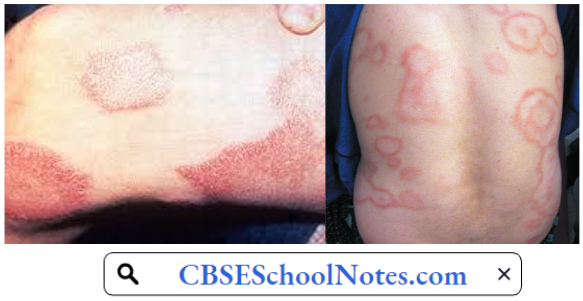
A thickened nerve is often accompanied by other signs as a result of damage to the nerve. These may be loss of sensation in the skin and weakness of muscles supplied by the affected nerve.
Leprosy Pathogenesis: Leprosy bacilli multiply in macrophages in the skin and Schwann cells of the nerves. Two forms of leprosy are known
- One form is “the tuberculoid type which is a mild form. M. leprae multiplies at the site of entry, usually the skin, invading and colonizing Schwann cells. The microbe then induces T-helper lymphocytes, epithelioid cells, and giant cell infiltration of the skin, causing infected individuals to exhibit large flattened patches with raised and elevated red edges on their skin.
- These patches have dry, pale, hairless centers, accompanied by a loss of sensation on the skin, The loss of sensation may develop as a result of invasion of the peripheral sensory nerves.
- The second form of leprosy, the “lepromatous type”, causes serious disfigurement is more virulent, In this form, the microbes proliferate within the macrophages as well as within the epithelial tissues of the face and ear lobes. Extension penetration of this microbe may lead to severe body damage; for example, the loss of bones, fingers, anel toes, and nose.
Leprosy Risk Factor: Prolonged contact with a patient of leprosy.
Leprosy Complications
- The most severe complications result from peripheral neuropathy, which causes deterioration of the sense of touch and a corresponding inability to feel pain and temperature.
- Patients may unknowingly burn, cut, or otherwise harm themselves. Repealed damage may lead to a Kiss of digits.
- Muscle weakness can result in deformities (for example, clawing of the 4th and 5th fingers caused by ulnar nerve involvement, fool drop caused by peroneal nerve involvement).
- Papules and nodules can be particularly disfiguring on the face.
- Feet: Plantar ulcers with secondary infection are a major cause of morbidity, making walking painful.
- Nose: Damage to the nasal mucosa can result in chronic nasal congestion and nosebleeds and, if untreated, erosion and collapse of the nasal septum.
- Eyes: Iritis may lead to glaucoma, and corneal insensitivity may lead to scarring and blindness.
- Sexual Function: Men with lepromatous leprosy may have erectile dysfunction and infertility. The infection can reduce testosterone and sperm production by the testes.
- Kidneys: Amyloidosis and consequent renal failure occasionally occur in lepro- malous leprosy.
Urinary Tract Infection: Urinary tract infections (UTls) are some of the most common bacterial infections, affecting 150 million people each year worldwide. About 40% of women and 12% of men experience at least one symptomatic UT1 during their lifetime, and as many as 40% of affected women show recurrent UTI.
- A urinary tract infection (UTI) is an infection in any part of the urinary system—kidneys, ureters, bladder, and urethra. Most infections involve the lower urinary tract—the bladder and the urethra. Women are at greater risk of developing a UT1 than are men, since they have very short urethra.
- Urinary tract infections (UTIs) are the most common outpatient infections, with a lifetime incidence of 50-60% in adult women. Serious consequences can occur if a UTI spreads to the kidneys.
Urinary Symptoms And Signs: Each type of UTI may result in more specific signs and symptoms, depending on which part of your urinary tract is infected.
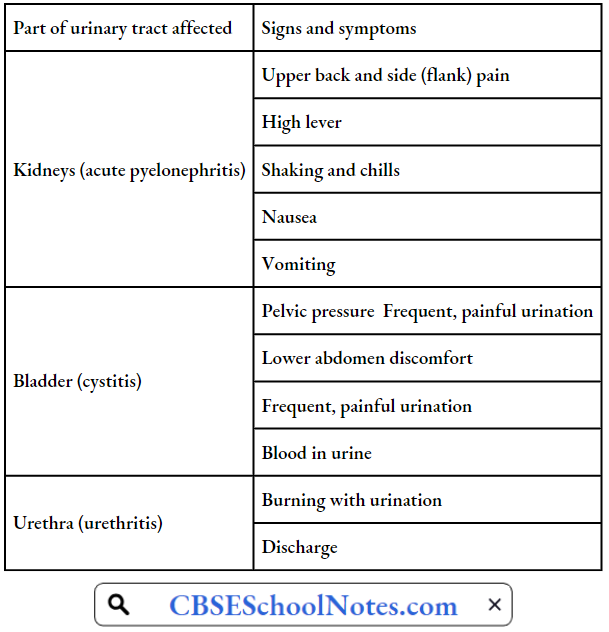
Microscopic examination of urine reveals a large number of white blood cells. Microbiological culture helps to identify the causative organism as well as its sensitivity to drugs.

Urinary Tract Infection Causes: Urinary tract infections typically occur when bacteria enter the urinary tract through the urethra and begin to multiply in the bladder. Although the urinary system is designed to keep out such microscopic invaders, these defences sometimes fail.
When that happens, bacteria may take hold and grow into a full-blown infection in the urinary tract. The most common UTIs occur mainly in women and affect the urinary bladder and urethra. Escherichia coli (E. coli) from the gut is the cause of 80-85% of community-acquired urinary tract infections.
Urinary Tract Infection Risk Factors: Risk factors specific to women for UTIs include
- Female Anatomy: A woman has a shorter urethra than a man does, which shortens the distance that bacteria must travel to reach the bladder.
- Sexual Activity.
- Menopause: After menopause, a decline in circulating estrogen causes changes in the urinary tract that make women more vulnerable to infection.
- Urinary tract abnormalities.
- Blockages in the urinary tract. Urinary obstruction by kidney stones or an enlarged prostate in males increases the risk of UTIs.
- Diabetes

Urinary Tract Infection Complications: When treated promptly and properly lower urinary tract infections rarely lead to complications. But left untreated, a urinary tract infection can have serious consequences
- Recurrent infections, especially in women.
- Permanent kidney damage from an acute or chronic kidney infection (pyelonephritis) due to an untreated UTI.
- Sepsis, a potentially life-threatening complication of an infection, especially if the infection spreads to the kidneys.
Gonorrhea: Gonorrhea, is a sexually transmitted infection (STI). It is a global problem. The World Health Organization estimates that 62 million people are infected annually worldwide. In the United States, it is the second most commonly reported communicable disease and the second most prevalent sexually transmitted infection. In India, its exact prevalence is not known because of non-reporting by the patients.
Gonorrhea Symptoms And Signs: In many cases, gonorrhea infection causes no symptoms. Symptoms, however, can affect many sites in the body, but commonly appear in the genital tract.
- Signs And Symptoms Of Gonorrhoea Infection In Men Include:
- Painful urination
- Pus-like discharge from the tip of the penis
- Pain or swelling in one testicle
- Signs And Symptoms Of Gonorrhea Infection In Women Include:
- Increased vaginal discharge
- Painful urination
- Vaginal bleeding between periods, such as after vaginal intercourse
- Abdominal or pelvic pain
- Gonorrhea Can Also Affect These Parts Of The Body:
- Rectum: Signs and symptoms include anal itching, pus-like discharge from the rectum.
- Eyes: Gonorrhea that affects the eyes can cause eye pain and pus-like discharge from the eye.
- Throat: Signs and symptoms of a throat infection might include a sore throat and swollen lymph nodes in the neck.
- Joints: If one or more joints become infected by bacteria (septic arthritis), the affected joints might be warm, red, swollen, and extremely painful, especially during movement.
Gonorrhea Cause: Gonorrhoea, is caused by the bacterium Neisseria gonorrhoeae.

Gonorrhea Pathogenesis: Transmission of infection from one person to another normally occurs during periods of close physical contact which allow the organisms to pass from the site of infection in one host, to a susceptible mucosal surface in a new one.
- The infection is usually transmitted during intimate sexual contact, the most common site of infection being the mucosa of the genital tract. In addition, babies born to mothers harboring gonococci in their genital tract may become infected during passage down the birth canal and may develop gonococcal conjunctivitis.
- Neisseria gonorrhoeae is an obligate human pathogen that causes mucosal surface infections of male and female reproductive tracts, pharynx, rectum, and conjunctiva. Asymptomatic infections in the lower reproductive tract of women can lead to serious, long-term consequences if these infections ascend into the fallopian tube.
- The damage caused by gonococcal infection and the subsequent inflammatory response produce the condition known as pelvic inflammatory disease (PID). Infection can lead to tubal scarring, occlusion of the oviduct, and loss of critical ciliated cells.
- These defects interfere with the normal transport of the ovum from the ovary to the uterus. Consequently, there is an increased risk of ectopic pregnancy and infertility.
Gonorrhea Complications: Untreated gonorrhea can lead to major complications, such as
- Infertility in women.
- Infertility in men.
- Infection that spreads to tire joints and other areas of your body.
- Increased risk of HIV / AIDS.
- Complications in babies. Babies who contract gonorrhea from their mothers during birth can develop blindness.
Syphilis: Syphilis is a bacterial infection usually spread by sexual contact. The disease starts as a painless sore—typically on your genitals. Syphilis is caused by a bacterium called Treponema pallidum. Syphilis spreads from person to person via skin or mucous membranes. During the last 50 years, the prevalence of this disease seems to have decreased.

After the initial infection, the syphilis bacteria can remain inactive (dormant) in the body for decades before becoming active again. Early syphilis can be cured, sometimes with a single shot of penicillin. Without treatment, syphilis can severely damage the heart, brain, or other organs, and can be life-threatening. Syphilis can also be passed from mothers to unborn children.
Syphilis Symptoms And Signs
- Primary Syphilis: The first sign of syphilis is a small sore, called a chancre. The sore appears at the spot where the bacteria entered the body. The chancre usually develops about three weeks after exposure. Many people who have syphilis do not notice the chancre because it is usually painless. The chancre will heal on its own within three to six weeks.
- Secondary Syphilis: Within a few weeks of the original chancre healing, the patient experiences a rash that begins on the trunk but eventually covers the entire body. Some people also experience fever, a sore throat, and swollen lymph nodes. These signs and symptoms may disappear within a few weeks.
- Latent Syphilis: In this stage, there are no symptoms and it lasts for many years.
- Tertiary Syphilis: About 15% to 30% of people infected with syphilis who do not get treatment will develop complications known as late (tertiary) syphilis Tertiary Syphilis is the most serious stage of infection and is characterized by three major complications:
- Gummatous Syphilis causes the formation of soft, tumor-like lesions called gummas. These non-cancerous lesions can cause large ulcerative sores on the skin and mouth, and erode tissues of the heart, liver, muscles, bones, and other vital organs. Symptoms typically develop between three and 10 years after being infected.
- Cardiovascular syphilis can cause severe inflammation of the aorta and the development of an aortic aneurysm (the swelling and weakening of the aortic wall). It generally occurs 10 to 30 years after the initial infection.
- Neurosyphilis affects the central nervous system and usually develops within four to 25 years of an infection. There may be severe neurological disorders including meningitis, degeneration of the spinal cord (tabes dorsalis), seizures, personality changes, hallucinations, dementia, schizophrenia, and stroke.
While the syphilis infection can be treated during the tertiary stage, any damage caused to the heart, kidneys, and other organs may be permanent and lead to end-stage organ failure.
HIV/AIDS: Acquired immunodeficiency syndrome (AIDS) is a chronic potentially life-threatening condition caused by human immunodeficiency virus (HIV).
- The World Health Organization (WHO) estimates that in 2017, about 37 million people, including 1.8 million children (< 15 years), were living with HIV worldwide; of the total, about 25.7 million live in sub-Saharan Africa.
- More than two million Indians are suffering from HIV/AIDS. By damaging one’s immune system, it interferes with the body’s ability to various organs that cause disease.
HIV/AIDS: Symptoms And Signs: Symptoms and signs vary with the stage of the disease
- Primary Infection (acute HIV)
- Fever
- Headache
- Muscle aches
- Joint pains
- Rash
- Swollen lymph nodes in the neck
- Clinically Latent Infection (Chronic HIV): There are no symptoms or signs in this stage. This stage may last 10 years.
- Symptomatic HIV Infection
- Fever
- Weight loss
- Fatigue
- Diarrhea
- Swollen lymph nodes
Progression To AIDS: This stage occurs when the patient’s immune system has been severely damaged. Pathogens that normally cannot attack the human body are now able to enter the body and produce disease.
Such bacteria, viruses, and fungi are called opportunistic pathogens. The body loses the ability to detect and destroy malignant cells. Therefore, the patient is more prone to develop cancer. At this stage, symptoms and signs may include
- Night sweats
- Persistent fatigue
- Recurring fever
- Weight loss
- Chronic diarrhea
HIV/AIDS Pathogenesis: The human immunodeficiency virus (HIV) mainly infects the CD4 cells (helper T-cells) in the immune system. Over years of HIV infection, CD4 cell numbers usually drop gradually, but constantly, and the immune system is weakened. When the CD4 cell number falls below 200 mm3, symptoms of AIDS develop. At this stage complications listed below begin to appear. Due to opportunistic infections/tumors, severe muscle wasting can be observed in the patient.
HIV/AIDS Spread: HIV infection is transmitted by sexual intercourse. One can also get HIV infection by coming in contact with infected blood directly or through transfusion of infected blood or the use of contaminated syringes.
Complications Of AIDS
- Viral Infections, such as Cytomegalovirus (CMV), herpes simplex, molluscum, contagious, herpes zoster, human papillomavirus (HPV), etc
- Bacterial Infections, such as recurrent bacterial pneumonia, Mycobacterium tuberculosis, Pseudomonas, septicemia vasculitis, etc.
- Fungal Infections, such as Candida, Pneumocystis jirovecii, pneumonia, Cryptococcus neoformans
- Protozoal Infections
- Tumors, such as Kaposi’s sarcoma, primary cerebral lymphoma, high-grade non-Hodgkin lymphoma, carcinoma of the cervix, etc.

HIV/AIDS Risk Factors
- Unprotected sex with a person with HIV / AIDS
- Infected blood transfusion
- Sharing injection needles with a person with HIV/AIDS
